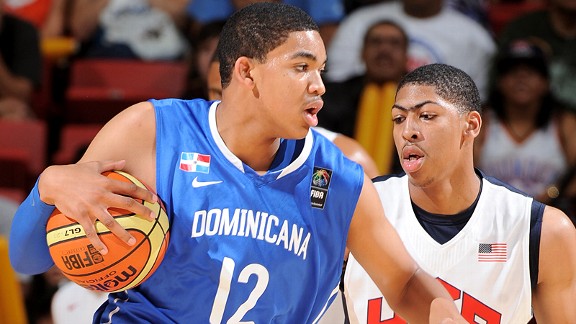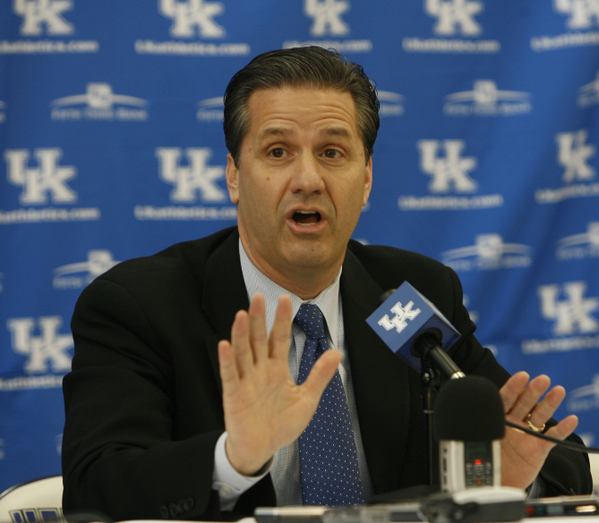SEC Preview: Kentucky Wildcats
Posted by Brian Joyce on November 14th, 2014The SEC microsite is wrapping up previews on each team this week, and with the start of the season approaching we begin wrapping up with the league favorite, Kentucky.
Kentucky Wildcats
Strengths. Kentucky has size, depth, athleticism, and nine McDonalds All-Americans at its disposal. The Wildcats welcome back a number of veterans, with 59 percent of last season’s scoring returning to Lexington. They welcome in another highly-ranked recruiting class, of which we have become accustomed to see at least one or two destined to succeed and proceed to the NBA. John Calipari roams the sidelines with a 2012 National Championship and five Final Four appearances under his belt. Someone might bring up vacated appearances, but it doesn’t take away the fact that Calipari was there, and the point here is that he has the necessary experience to guide Kentucky to the promised land once again. Another Final Four run, an SEC championship, and title number nine all seem well within the grasps of the eager paws of a more than capable platoon.
Weaknesses. Kentucky’s laundry list of strengths does not imply that this team is without a weakness. One of the areas of most concern is at the three position. Alex Poythress and Trey Lyles will both play out of position at the three, causing match-up nightmares for the opposition but also presenting a challenge in a couple of ways. First, both are still developing the ball-handling skills that Calipari is accustomed to having on the wing. Second, a potentially more difficult challenge to address will be defense. Poythress and Lyles will be forced to guard smaller, quicker wing players. Poythress is fairly quick and a good shot-blocker — and there are always several good defenders waiting underneath on Kentucky’s front line — but a true small forward with excellent quickness could give these bigger defenders some trouble. We’d also be remiss for failing to mention the possibility that someone becomes unhappy with his playing time this season. Dissatisfaction can occur on any team within any program, so we have to acknowledge the possibility of unmet expectations here. However, it seems that Kentucky is very well-situated with its depth to deal with a disgruntled player. If someone lets up in practice or games, he knows that somebody else is more than ready to fill his spot. In such a case, Calipari has the luxury of looking down a long bench to find a replacement.
Toughest non-conference test. Kentucky put together its familiar gauntlet of the best teams in college basketball with early non-conference tests against Kansas, North Carolina, UCLA, and of course rival Louisville, so take your pick. Calipari is now 6-1 at Kentucky against his old buddy Rick Pitino, and the Wildcats’ trip to the Yum! Center represents their only true road game before SEC play. That match-up will come with a lot of hype, of course, but for my money, the more interesting test will come against the frontcourt of Texas. Cameron Ridley and newcomer Myles Turner will give the Wildcats’ big men an early season gauge of where they stand when facing other legitimate seven-footers. Texas is a Final Four contender, as are multiple other teams on the Wildcats’ non-conference slate, but the Longhorns might have the best big men Kentucky will face outside of its own practices in Lexington.
Toughest conference stretch. February brings back-to-back road games at Florida and at LSU. If Kentucky is going to lose during conference play, it will likely come during one of these two games. Kentucky lost twice last year in Rupp Arena and twice the year before, but those four losses are the only home defeats in the Calipari era. It will be difficult to beat them at home this season, so the smart money says a defeat comes at the hands of an opponent with the backing of a crazy student section, perhaps in a moment when Kentucky’s guard is down. Florida will garner Kentucky’s full attention. If Florida isn’t able to take down the Wildcats in the O-Dome, will it prove too much for this squad to turn immediately around and face LSU in the Maravich Assembly Center on a Tuesday night? If Kentucky overlooks a very good Tigers team, February 10 could be a difficult game.
Projected starters:
- G Andrew Harrison (6’6” – 10.8 PPG, 3.1 RPG, 4.0 APG)
- G Aaron Harrison (6’6” – 13.7 PPG, 3.0 RPG, 1.9 APG)
- F Alex Poythress (6’8” – 5.8 PPG, 4.5 RPG, 0.4 APG)
- F Karl Anthony-Towns (6’11” – 20.9 PPG, 13.4 RPG, 6.2 BPG)*
- C Willie Cauley-Stein (7’0” – 6.8 PPG, 6.1 RPG, 2.9 BPG)
*High school statistics

Karl Anthony Towns may be the only newcomer in the starting five, but he might just be the most talented player on the court for the Wildcats this season (Getty).
The first platoon is anchored with experience and size. Calipari returns four players along with a freshman who will most likely suit up for an NBA team at this time next year. Everyone on the court stands 6’6” or taller, making the first five even more difficult to defend. The talent that accompanies these characteristics makes this a dangerous team with few weaknesses. Karl Anthony-Towns is the new guy on the low block, but he figures to be a standout because of his solid mid-range jumper, soft touch around the rim, and excellent passing and rebounding abilities. And of course, if Kentucky needs a three-point jumper from the left wing, it should know exactly who to look for.
Projected bench:
- G Tyler Ulis (5’9”)
- G Devin Booker (6’6”)
- F Trey Lyles (6’10”)
- F Marcus Lee (6’9”)
- C Dakari Johnson (7’0”)
- F Derek Willis (6’9”)
- G Dominique Hawkins (6’0”)
How long Calipari sticks with the platoon system remains to be seen, but for the now it seems that the second five will garner the same amount of playing time as the starting five. Players this talented will see the floor, but I am not convinced that the five-in, five-out platoon system will survive a full college basketball season.
If everything goes right… Kentucky could not beat an NBA team. It wouldn’t happen. It’s impossible primarily because such a game will never occur, but even if Calipari pulled some strings and arranged it, a relatively young and inexperienced college team just wouldn’t beat an NBA team full of veteran professionals. While we are dispelling absurd myths, the Wildcats won’t go 40-0 either. It is worth noting that discussion of an undefeated season is a lot more plausible than beating the Philadelphia 76ers, but there are just too many good teams on this schedule for the Wildcats to not slip up at least once. 38-2; maybe 37-3? Yeah, I’m buying that. 18-0 in the SEC? I wouldn’t argue with that sentiment either. If everything goes right, Kentucky will cut down the nets in nearby Indianapolis for its ninth national championship. A 6-0 run through the NCAA Tournament is the unbeaten streak on which this team should focus, and the only attainable goal that matters. Big Blue Nation doesn’t really care about running the table or beating a bottom-feeding professional team. Another championship banner in the rafters of Rupp Arena is indeed the most realistic goal for a team and a fan base that want nothing more.
If nothing goes right… Kentucky was a strong national title contender during Calipari’s first season in Lexington, with future NBA stars John Wall, DeMarcus Cousins and Eric Bledsoe on the roster. On its way to what seemed like an inevitable Final Four, the Wildcats met Bob Huggins’ West Virginia team, which played a 1-3-1 zone and dared Kentucky’s athletic and imposing stars to beat him from the outside. They couldn’t. They misfired early and often from beyond the arc (4-of-32) and failed to convert at the free throw line as well (16-of-29). Talent does not always win out in a long season. However, this year’s Kentucky team will not shoot 12.5 percent on 32 attempts from beyond the arc for two reasons: Kentucky should not under any circumstances shoot 32 times from long-range. The Cats are too big and talented in the paint to chuck up that many three-point shots, 1-3-1 zone or not. Secondly, this version is a significantly better shooting team than the one that fell flat in Calipari’s inaugural campaign. Devin Booker, Aaron Harrison and Tyler Ulis can all knock down open shots. Even Lyles can knock down the triple on occasion (they don’t call him “Trey” for nothing). While outside shooting is not an area in which Kentucky excels, it also should not be identified as a weakness. But if I am an opposing coach lining up against the Wildcats with a Final Four berth on the line, I am going to channel my inner Huggins. I would walk out of the locker room in my finest warm-up suit, maybe a matching turtleneck with the jacket zipped high, and I would line my team up in a 1-3-1 zone and hope I could frustrate the Wildcats into oblivion. That seems like a far better option than allowing the Wildcats to go ham with alley-oops and post-ups near the rim. If nothing goes right this season, Kentucky will go cold at the wrong place and the wrong time. Anything short of a second straight Final Four appearance (the fourth in five years) and a ninth National Championship will fail to meet expectations, so the Big Blue Nation can’t help but be disappointed by what-ifs when a dominant regular season comes crashing down because a bad game occurs at the worst possible time.













































